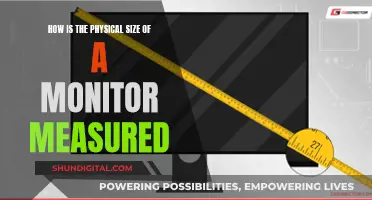
With rising electricity prices, many people are looking for ways to lower their energy usage and save on their power bills. Monitoring your energy usage can help you identify which appliances are consuming the most power and where you can cut back. There are several ways to track your energy usage, such as using a smart meter, a home energy monitor, or energy-tracking apps. These tools can provide real-time data on your energy consumption, helping you make more informed decisions about your energy usage and allowing you to take control of your power bills.
| Characteristics | Values |
|---|---|
| Methods of Tracking Energy Usage | Smart meters, home monitoring systems, smart plugs, energy-tracking apps |
| Purpose of Tracking Energy Usage | To lower energy usage and save on power bills |
| Benefits of Tracking Energy Usage | Increases awareness, lets you know which electronics consume the most power, helps establish minimum energy consumption, shows trends in electricity usage, helps decide whether to change energy retailers |
| Energy Units | Kilowatt-hour (kWh), kilowatt (kW), joule (J), watt (W) |
| Average UK Household Usage | 8.5-10 kWh per day |
| Examples of Appliance Energy Consumption | Heating system (100-3,500 kWh/month), air conditioner (1,400-1,800 kWh/month), water heater (300-400 kWh/month), refrigerator (162-205 kWh/month), lighting (50-300 kWh/month) |
| Examples of Energy-Tracking Apps | Green Outlet, Nest Mobile, Meter Plug, Meter Readings, Energy Cost Calculator, Emporia Energy, mySunPower |
| Examples of Home Monitoring Systems | TED Pro Home, Sense Energy Monitor, Eyedro Home Solar & Energy Monitor, WeMo Insight Switch, Elgato Eve, D-Link Wi-Fi Smart Plug |
What You'll Learn

Use a smart meter to monitor real-time energy usage
Smart meters are an effective way to monitor real-time energy usage. They are digital utility meters installed by power companies that send wireless signals or power line signals to show how much electricity your house is using. This makes it easy for power companies to check your energy usage from a distance, and they often provide regular reports on how much energy your home is using.
Smart meters are highly adept energy trackers that provide detailed energy consumption in real time without a technician's services. They link to in-home displays and web portals, which can be viewed on your computer or smartphone apps. Some power companies also provide guides on how to lower your energy usage.
If you have a smart meter, you can monitor your total energy usage, usually from day to day, through your power company's website or app.
Smart meters are a great way to monitor real-time energy usage as they provide detailed energy consumption data without the need for manual readings. They are also widely available, with many power companies upgrading to these meters.
- Easy access to energy consumption data through in-home displays, web portals, or smartphone apps.
- Ability to track energy usage trends and make informed decisions to reduce consumption or costs.
- Regular reports on energy usage, allowing you to identify areas where you can save energy.
- Identification of appliances or devices that use the most energy, helping you make informed decisions about usage and potential upgrades.
- No need for manual readings or technician visits, as smart meters provide real-time data.
By using a smart meter, you can gain valuable insights into your energy usage patterns and make informed decisions to reduce your energy consumption and costs.
Monitoring WiFi Usage: Track, Analyze, and Optimize Your Network
You may want to see also

Compare energy costs with an appliance energy calculator
There are several ways to monitor your energy usage at home, and one of the most effective ways is to use an appliance energy calculator. These calculators can be found online and are a great way to determine your kW consumption.
To calculate your home energy use, you input the wattage of the appliance or device and the number of hours it is used each day. The calculator will then work out the estimated daily, monthly, or yearly energy consumption of the appliance, as well as the costs involved.
For example, let's say you want to calculate the cost of running your electric kettle for a year. First, you need to estimate how long the kettle is used for each day. If you use it several times a day, you might estimate that it is on for about an hour in total. Next, you need to find out the wattage of the kettle, which is usually stamped on the bottom or back of the appliance. In this case, let's say it's 1500 W. You can then plug these numbers into the calculator, which will give you the daily and annual energy consumption of the kettle in kilowatt-hours (kWh). Finally, to get the annual cost, you multiply the annual energy consumption by the utility rate per kWh.
Using an appliance energy calculator is a great way to pinpoint which of your appliances are the most energy-hungry and may be worth replacing with newer, more energy-efficient models. It's also a useful tool for working out how much money you could save by making small changes to your daily habits, such as turning off appliances that aren't being used or switching to LED light bulbs.
In addition to online calculators, there are also smartphone apps that can help you track your energy usage and calculate costs. Some examples include the Green Outlet app, the Nest Mobile app, and the Energy Cost Calculator app. These apps can provide real-time data and alerts, helping you to make more informed decisions about your energy usage.
By comparing energy costs with an appliance energy calculator, you can make more informed choices about your appliance usage and identify areas where you can cut back, save money, and boost your home's energy efficiency.
Electricity Monitors: Accurate or Deceitful?
You may want to see also

Use a smart plug to monitor individual appliances
Smart plugs are a great way to monitor individual appliances and can be a useful tool for those with mobility or dexterity issues. They are also ideal for renters or those who are unable to rewire their breaker boxes for a full system.
Smart plugs are simple to use and can be controlled via an app or smart home hub. They are easy to set up and can be used with voice commands through smart speakers. They can also be used to create schedules, timers, and routines to automate your appliances. For example, you can set a schedule to ensure that your hair straightener is not left on for too long, or create a routine to turn on your Christmas tree lights at sunset.
Smart plugs can also help you monitor your energy usage and lower your electricity bill. They can track the run time of devices in hours and minutes, and some can even monitor energy usage in kilowatt-hours or dollars and cents. This allows you to see how much power your devices are consuming and make changes to reduce your energy consumption.
When choosing a smart plug, consider the following:
- Compatibility with your smart home platform: Ensure that the smart plug is compatible with your smart home platform, such as Amazon Alexa, Apple Home, or Google Home.
- Energy monitoring: Look for a smart plug that includes energy monitoring features to help you track your energy usage and potentially lower your electricity bill.
- Size: Consider the size of the smart plug, especially if you have limited space or need to use it in a tight space.
- Physical buttons: Opt for a smart plug with physical buttons so you can turn it on or off without relying on another device.
- Additional features: Some smart plugs offer additional features such as Away Mode, which randomly turns devices on and off to make it look like someone is home.
- TP-Link Kasa Smart Wi-Fi Plug Slim (EP25): This smart plug is widely compatible with major smart-home platforms and includes features such as energy monitoring and Away Mode. It is easy to set up and use, and it offers the most features for its price.
- TP-Link Tapo TP25 Outdoor Plug: This outdoor smart plug has a robust weather-resistance rating and dual outlets that can be controlled independently. It also tracks the run time of devices.
- TP-Link Kasa Smart Wi-Fi Power Strip (HS300): This power strip turns one outlet into six independently controlled smart ones and includes three USB ports. It offers features such as energy monitoring, sunrise/sunset scheduling, and Away Mode.
- TP-Link Kasa Smart Wi-Fi Plug Mini (EP10): This tiny smart plug is perfect for tight spaces and offers features such as built-in usage monitoring and Away Mode. However, it does not support Apple Home.
Colleges Monitoring Student Online Activity: Is Privacy Invasive?
You may want to see also

Understand your energy bill and standing charges
Understanding your energy bill is an important step in monitoring your energy and gas usage at home. Energy bills can be complicated, but they typically consist of two main charges: the unit rate and the standing charge.
Unit Rate
The unit rate is the cost you agreed to pay your energy supplier for each kilowatt-hour (kWh) of gas or electricity you consume. The unit rate can be fixed or variable. It is important to note that the unit rate only applies to the energy you actually use, and it is usually measured by a meter.
Standing Charge
The standing charge, on the other hand, is a fixed daily charge that you pay regardless of your energy consumption. This charge covers the cost of being connected to the energy network and maintaining the supply of gas and electricity to your home. Standing charges also include the cost of visiting homes to take meter readings and supporting government social and environmental schemes.
Standing charges are set by your supplier and vary depending on your location and payment method. They are typically higher in rural areas, as the energy supply has to travel a longer distance. Additionally, standing charges are included in the energy price cap, which is reviewed and adjusted every three months by the energy regulator, Ofgem.
While standing charges are standard, some suppliers may not include them in their tariffs. Instead, they may charge a higher rate for the first one or two units of energy consumed. It is important to compare energy suppliers and their standing charges, as they can significantly impact your overall energy bill, especially if you have a low energy consumption.
Understanding Your Bill
When reviewing your energy bill, it is essential to consider both the unit rate and the standing charge. The unit rate will vary based on your energy usage, while the standing charge will remain fixed. By understanding these charges and monitoring your energy consumption, you can make informed decisions to optimise your energy usage and reduce your overall energy costs.
Monitoring Electricity Usage: Room-by-Room Power Insights
You may want to see also

Try a smart home energy monitor
Smart home energy monitors are a great way to keep track of your energy usage and reduce your bills. These devices attach to your electrical panel and can be easily integrated into your home network. They provide real-time data on your energy consumption, allowing you to see how much electricity each appliance is using. This information can help you identify which appliances are the most energy-intensive and may need to be used less frequently or replaced with more energy-efficient models.
There are a variety of smart home energy monitors available on the market, such as the Sense Energy Monitor, which connects to iOS, Android, and web apps, and the Eyedro Home Solar & Energy Monitor, which uses clip-on modules that attach to individual circuits in your breaker box. These monitors typically range in price from $99 to $349, with some offering additional features such as solar energy monitoring or integration with smart home hubs.
Smart home energy monitors can also help you establish a baseline for your energy usage and set goals for reducing your consumption. By tracking your progress over time, you can make informed decisions about your energy habits and choose the most effective ways to lower your bills.
In addition to the financial benefits, smart home energy monitors can also help you reduce your carbon footprint. By identifying which appliances are using the most energy, you can make more environmentally friendly choices and lower your overall energy consumption. This not only benefits the environment but can also help you save money on your energy bills.
Smart home energy monitors are a great investment for anyone looking to take control of their energy usage, reduce their carbon footprint, and lower their utility costs. With real-time data and insights, you can make informed decisions about your energy habits and choose the best ways to optimize your energy usage.
Hotels and Internet Privacy: Monitoring Guest Online Activity
You may want to see also
Frequently asked questions
You can monitor your energy and gas usage at home by taking readings from your meter, installing a smart meter, or checking your latest energy bill.
Tracking your energy usage can help you reduce your energy bills and your carbon footprint. It can also help you identify which appliances are using the most energy, so you can make informed decisions about your energy consumption.
Smart meters are digital utility meters installed by power companies that send wireless signals to show how much electricity your house is using. They provide detailed energy consumption data in real time and often give you access to regular reports on your energy usage.
Recommended apps for tracking energy usage include Nest Mobile, Meter Readings, Green Outlet, Energy Cost Calculator, and Meter Plug. These apps can help you monitor your energy consumption, calculate costs, and in some cases, control your appliances remotely.
Yes, smart plugs like WeMo Insight Switch, Elgato Eve, and D-Link Wi-Fi Smart Plug can help you monitor energy usage for individual appliances. Home energy monitors like TED Pro Home, Sense Energy Monitor, and Eyedro Home Solar & Energy Monitor can provide a more comprehensive view of your energy usage by connecting to your electrical panel.







